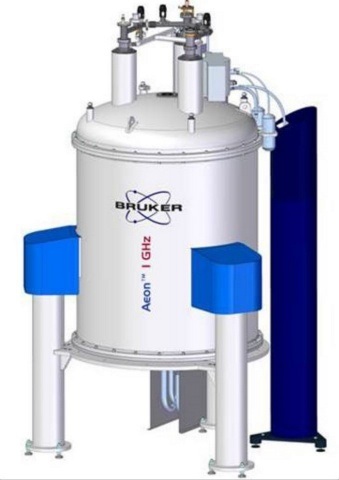NMR provides a range of structural and interaction insight that can complement other powerful techniques such as X-ray crystallography, mass spectrometry and electron microscopy to help researchers observe biology in real time at a true molecular level.
The ability to link structural, kinetic, thermodynamic, and dynamic information across the field of molecular biology gives NMR true value.
_is_a_transcription_factor_whose_inactivation_can_trigger_the_onset_of_cancer-petarg-590.jpg)
Ribbon model of p53 protein bound to DNA molecule. p53 (aka tumor protein 53) is a transcription factor whose inactivation can trigger the onset of cancer. © petarg /shutterstock.com
Limitations of NMR spectroscopy
NMR spectroscopy is generally limited in the study of large molecules or complexes because with increasing molecular mass the line widths in the spectra become progressively broader leading to poor resolution. This is because longer rotation times and shorter relaxation time (T2) of large molecules mean NMR signals decay much more rapidly.
NMR: A Trend in Medical Research
Transverse relaxation optimized spectroscopy (TROSY)
Transverse relaxation optimized spectroscopy (TROSY) is a technique used in the interpretation of large protein structures.1 TROSY optimizes the poor signal from the fast decay of magnetization by constructive usage of the two effects that determine T2 in protein macro-molecules at high magnetic field strengths.
These two effects are dipole-dipole coupling and chemical shift anisotropy of the two spins, which achieve equality at a magnetic field of 1.1 – 1.2 GHz, cancel out and provide the maximum TROSY effect. 2,3
Advances in TROSY NMR
A recent development in TROSY NMR is the use of the 15N-H coupling in multi-dimensional heteronuclear experiments for large proteins4 to provide a new sensitive technique.
Previously 15N has been under-used in protein NMR because of the low gyromagnetic ratio (γ) of nitrogen and a perception of low sensitivity. However the use of 15N couplings have been proposed as being more useful than their 1H counterparts in providing an insight into protein structure and consequently its function.5
Takeuchi et al have shown in their 2015 paper, ‘Nitrogen detected TROSY at high field yields high resolution and sensitivity for protein NMR’ in the Journal of Biomolecular NMR, that TROSY 15N-H experiments can provide high quality spectra in instrumentation with high field magnets such as the Bruker Avance 500 and Avance III 800 spectrometers (data processed with Bruker’s TOPSPIN).
The new TROSY experiments take advantage of slow 15N transverse relaxation (T2) and compensate for low sensitivity by using high magnetic field strength. 15N detected 2D 1H-15N experiments provide high quality 2D spectra following a 13 hour accumulation at 800MHz (18 hour accumulation at 500 MHz).
The use of 15N detection means deuteration is not required and a wider range of proteins (Eukaryotic expression included) can be studied in simple H2O. This also means that the problem of incomplete amide proton back exchange is resolved and the detection of amide groups in the core of large proteins is made decidedly easier.
Often large molecular weight proteins expressed in D2O cannot be refolded for amide back exchange and therefore have limited use in NMR conformation and structure experiments.
The new 15N-H TROSY process provides an additional way to examine the inner structure and function of high molecular weight proteins especially at field strengths approaching 1GHz.
High field strengths are where the most pronounced TROSY effect can be obtained and this is shown by increased peak height and a narrower signal.
Bruker instrumentation for new 15N TROSY

For the 15N TROSY experiments Bruker provide a range of high-field instruments such as the Avance 500, which is designed to study the conformation of small peptides and proteins and to follow enzymatic reactions in real time.
In addition for high field experiments the Avance HD III 800 spectrometer provides a range of advantages for biologists including a multi-channel receiver allowing more than one experiment to be conducted at once and high-speed RF generation and data acquisition allowing complex experiments like TROSY to be conducted in a shorter time-scale.
The Bruker Avance series can now also be configured with a 1GHz magnet, which is ideal for the high-field requirements of the TROSY technique.6
References
- Rance M, Loria JP, Palmer AG. (1999) J. Mag. Res. 136, 92-101.
- Pervushin K, Riek R, Wider G, and Wüthrich K. (1997) Proc. Natl. Acad. Sci. USA 94 12366-71
- Pervushin K. et al., (1998) J. Biomol. NMR, 12:345-348
- Takeuchi K, Arthanari H, Shimada I, Wagner G. J Biomol NMR. 2015 Oct 23
- Takeuchi K. et al., (2012) Recent Developments in Biomolecular NMR, Royal Society of Chemistry
- https://ir.bruker.com/press-releases/press-release-details/2015/Bruker-Introduces-Next-Generation-GigaHertz-NMR-Technology-at-ENC-2015/default.aspx
About Bruker BioSpin - NMR, EPR and Imaging

Bruker BioSpin offers the world's most comprehensive range of NMR and EPR spectroscopy and preclinical research tools. Bruker BioSpin develops, manufactures and supplies technology to research establishments, commercial enterprises and multi-national corporations across countless industries and fields of expertise.
Sponsored Content Policy: News-Medical.net publishes articles and related content that may be derived from sources where we have existing commercial relationships, provided such content adds value to the core editorial ethos of News-Medical.Net which is to educate and inform site visitors interested in medical research, science, medical devices and treatments.